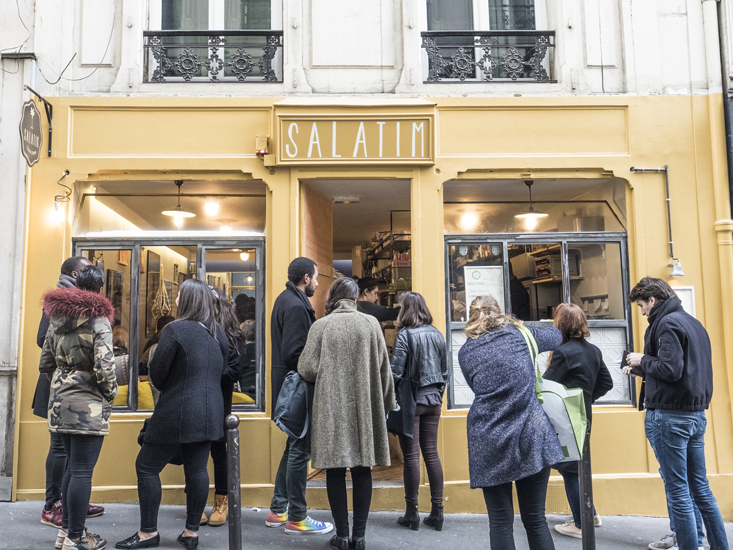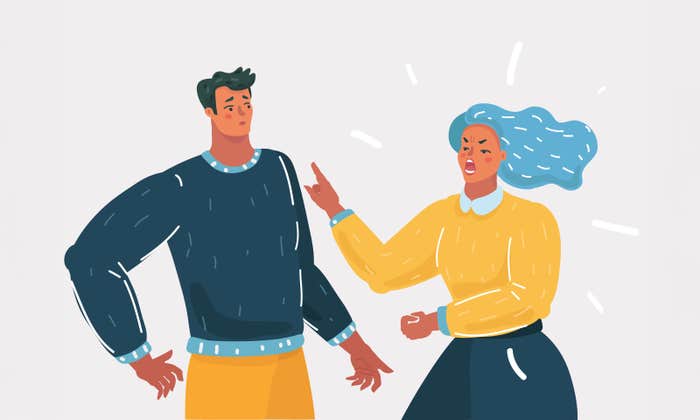It’s a cold evening in New York City and I’m making Nepalese donuts. Or, I should say, Rachana Rimal, a cheerful woman with a dash of sassiness, is teaching me and five other novice cooks to make them. The savory scent of spices in Rimal’s kitchen in Queens allows us to feel like we’ve been transplanted to her childhood home in Kathmandu, where she learned to cook by watching her mother work magic with recipes handed down over generations. “I’m sharing my food, my culture,” Rimal says to us with a smile.
We grind rice into a flour, sprinkle in sugar, roll the dough into circles, and drop our donuts into bubbling ghee, a pungent butter. However, making the next dish, dumplings, with spinach, cheese, cilantro, ginger, and a spicy tomato sauce, is more of a challenge. But Rimal guides us through the preparation with patience. We’ve signed up to cook with her through The League of Kitchens, an organization that arranges cooking classes in the New York City homes of international cooks. “We create opportunities for people to connect across cultural differences,” says Lisa Gross, founder of The League of Kitchens. “And have an amazing eating experience.”
Gross is right on the second count. Eating the food that Rimal helped us prepare was amazing. But do food and eating really help people connect across cultural differences? It’s a question you might ask Trump administration officials who recently made news for eating at Mexican restaurants during an immigration crisis at the southern border of the United States.

According to anthropologists and psychologists who have studied food in recent years, cuisines from international cultures can take us out of ourselves and help us better understand distinct people and cultures. The secret ingredient is empathy. And the process begins with stirring our emotions.
Evolutionary anthropologist John S. Allen, author of the 2012 book, The Omnivorous Mind, explains that the hippocampus, a part of the brain important for memory, is also part of the limbic system, which holds our emotional center, and is connected to our sense of smell. Due to the trifecta connection among the hippocampus, limbic system, and the sense of smell, food can play a powerful role in stimulating emotional reactions.
“At a very basic level, especially when you’re younger, those connections to emotion are [formed],” says Allen. For instance, we may associate the taste of a hamburger with the emotional warmth of a family barbecue. “You’re not aware of them, and then there’s something that evokes them that’s similar. It’s really convergence, but really we’re saying let’s exploit that convergence and hit those pathways we’re not even aware exist.”
Cooking and eating have a unique way of breaking down prejudices and inspiring unity.
Allen says that in all cuisines, certain textures and tastes appear to have universal appeal. Crunchiness, for example, in grilled meats, carrots, or deep-fried foods, is a cross-culturally enjoyed characteristic in one’s meal, and crunchy and crisp textures have been found to enhance your interest and desire for a specific food or cuisine. He adds this is the result of an evolved preference from our primate ancestors, who came to associate crunch as a positive characteristic: a sign of freshness in plant matter or the chitin shell of protein-laden insects.
In Allen’s view, the “heightened associations” that people have with universal qualities in food can enhance emotional connections. David Chang, founder of the popular Momofuku restaurant group in New York, has witnessed that convergence among diners at his restaurant Nishi. One day, he saw three Korean men crying after they ate a bowl of his chicken and dumplings. Although it may seem odd the men were bawling over a simple Western dish, Chang knew what had happened. “Our chicken and dumplings is basically the same thing as this Korean stew called sujebi,” Chang wrote in Wired.1 “They’ve both got an umami-rich broth—one is made with chicken, the other with seaweed and dried anchovies, so these guys were completely overwhelmed, because they ordered chicken and dumplings but were tasting sujebi.”
Demonstrating that food and eating can help us appreciate another culture was the goal of Jon Rubin, an interdisciplinary artist and associate professor of art at Carnegie Mellon University. With fellow artist Dawn Weleski, Rubin directed Conflict Kitchen, a restaurant in Pittsburgh, for seven years. The pair researched and prepared cuisines from nations with which the United States was in conflict, including Palestine, North Korea, and the Iroquois Confederacy. “One of the things we feel the restaurant has done fairly well is use food as a way of bypassing people’s defenses in order to pull them into narratives that are sometimes foreign and not always comfortable,” Rubin said in a 2015 interview with Guernica.2 After winning “a passionately loyal local following,” reported the Pittsburgh Post-Gazette, the restaurant closed in 2017.
The conflict-kitchen concept, however, lives on. The governments of Thailand and South Korea have funded global efforts to increase the number of their nations’ restaurants abroad to bolster their presence on the cultural stage.3 After Trump signed a first draft of his travel ban in early 2017 to prevent residents from nations like Syria and Iran entering the United States, many restaurateurs and supper clubs began organizing dinners and meals pertaining to the cuisine of banned nations.

Food, of course, isn’t the only way our senses enter another culture. Universal elements of music, such as rhythm and melody, move listeners emotionally, even if the song’s language or instrumental texture is foreign. In a recent study, experimenters had subjects listen to five minutes of pop music from West African and Indian cultures. They discovered a number of subjects’ unconscious cultural biases had been affected by the music.4 Many listeners who scored relatively highly on an empathy questionnaire possessed positive feelings toward the foreign cultures. In the throes of music, says Eric F. Clarke, a musicologist at the University of Oxford, and one of the paper’s co-authors, listeners were capable of conceptualizing other cultures and their citizens. “This other culture that seemed like a black box, that seemed unknown, we can now grasp it,” he says.
Clarke says the same thing could go for food. A culture may seem unfamiliar to a person, but after that person discovers the way people from an unfamiliar culture “prepare their food, the way they eat, somehow they understand it. There’s link between you and them, and that gives you insight.”
Food alone, though, is often not enough to complete the trip to another culture. The journey needs other people.
By sharing family recipes, many Israeli and Palestinian mothers came to understand one another.
In a recent study, evolutionary psychologist Robin Dunbar found that eating with others provides individual and social benefits, including a greater sense of closeness with others, as well as trust in them.5 Common practices at meals, storytelling and laughter, trigger the release of endorphins, causing a bonding effect. Research has also found that endogenous opioids such as endorphins, which are related to feelings of pleasure and part of a mechanism that regulates eating and appetite, are released in the brain after eating.6 “We know these endorphin kicks really make you feel engaged with, and bond with, the people you [eat] it with,” Dunbar says.
The idea that there needs to be a personal connection for food to upend our cultural biases echoes Gordon Allport’s “contact hypothesis,” also known as “Intergroup Contact Theory.” Allport’s thesis states that interaction between members of different ethnic groups can be sufficient in reducing intergroup prejudices and conflict.
In a 2011 paper, Linda Tropp, a social psychologist at the University of Massachusetts, Amherst, found that intergroup contact mitigates people’s preconceived prejudices by reducing people’s anxiety of threat and increasing their capacity for empathy toward members of other groups.7 This works through direct contact between intergroup members, as well as indirectly through mass media.
Using food to create intergroup contact theory is exemplified by the cookbook Jam Session, which features recipes from Israeli and Palestinian mothers who attended forums put on by the Parents Circle-Families Forum. Many of them had lost children to physical violence resulting from the ongoing Israeli-Palestinian combat. But according to a report in the Israeli newspaper Haaretz, after attending a number of these “jam sessions,” where these women would interact with individuals from the other side by sharing passed-down family recipes, many came to understand the opposing cultural community not as villains, but as humans just like themselves.
In one study, Tropp and her co-authors paired students from different ethnic backgrounds and had them participate in hour-long friendship activities once a week, for six to eight weeks. In addition to interviewing subjects, Tropp and her co-authors collected a baseline sample of their cortisol levels, a hormone connected to stress, before they were paired, and then compared that to samples collected after the friendship-building tasks. The researchers found at the end of the study that levels of anxiety and stress decreased over time. Diary entries showed that those participants paired with partners of a different ethnicity were more likely to initiate interactions with people of different ethnicities after the weekly activities than those who had been paired with partners of the same ethnicity as themselves.
“You’re approaching these cultural exchanges in the form of relationship,” says Tropp. “You’re trying to learn and understand. You’re allowing yourself to be affected somehow by a community that’s different from your own.”
Kaitlin Woolley, an assistant professor of marketing at Cornell University, and Ayelet Fishbach, a professor of behavioral science and marketing at the University of Chicago, showed just how special food can be at brokering a social bond. In a series of experiments, Woolley and Fishbach had participants play the role of a union leader or managerial position.8 They then gave them either identical or different types of food (chips or candy). When the participants ate the same type of food, they required half as many rounds to agree on a wage raise in comparison to when they ate different foods. The researchers found that eating the same food fostered a sense of trust and cooperation more strongly than wearing the same-colored shirt or eating different foods. By eating the same food, the authors conclude, “people can immediately begin to feel camaraderie and develop a bond, leading to smoother transactions from the start.”
In their paper, Woolley and Fishbach admit that eating food from another culture is not necessarily “indicative of whether two people will get along or someone is trustworthy.” Without the ingredient of human empathy, food from another land can only have a bland effect. But for people with open minds, like my fellow amateur cooks in New York, food was a bridge to Nepal. Sitting and eating around the kitchen table, Lynne, a yoga instructor visiting from Minnesota, exclaimed to our host Rimal, “I feel like I’ve gained an aunt!”
Matthew Sedacca is a writer based in New York. You can follow him on Twitter @matthewsedacca.
References
1. Chang, D. The Unified Theory of Deliciousness. Wired (2016).
2. Haines, C. Jon Rubin: Conflict Kitchen. Guernica (2015).
3. University of Southern California “Eight Great Gastrodiplomacy Nations” (2015).
4. Vuoskoski, J.K., Clarke, E.F., & DeNora, T. Music listening evokes implicit affiliation. Psychology of Music 45, 584-599 (2017).
5. Dunbar, R.I.M. Breaking bread: The functions of social eating. Adaptive Human Behavior and Physiology 3, 198-211 (2017).
6. Tuulari, J.T., et al. Feeding releases endogenous opiods in humans. Journal of Neuroscience 0976-17 (2017).
7. Pettigrew, T.F., Tropp, L.R., Wagner, U., & Christ, O. Recent advances in intergroup contact theory. International Journal of Intercultural Relations 35, 271-280 (2011).
8. Woolley, K. & Fishback, A. A recipe for friendship: Similar food consumption promotes trust and cooperation. Journal of Consumer Psychology 27, 1-10 (2017).


























